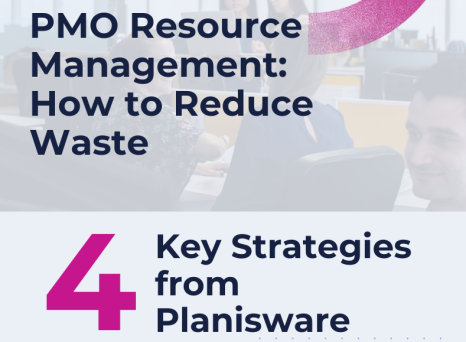It's a truth universally acknowledged that a Portfolio Manager in possession of a good portfolio will one day be faced with the question: what metrics should I track, and how? Industry events such as the annual Marcus Evans conference on Pharma Resource Planning & Portfolio Management are great places to learn about what other companies are using, and the 14th edition didn't disappoint: it was a knowledge drop of key portfolio metrics for better portfolio optimization in the Pharma industry.
The complexity of pharma project processes (and in particular the heavy regulatory burden) means that the number of possible metrics for managing your portfolio can be a bit daunting. Here are the top 5 metric categories and how they are used for portfolio optimization.
1. Project/Portfolio metrics
First and foremost, the project data needs to be completely trusted data from a single source of truth system. It may sound a bit trite, but if your project data is incomplete, then your metrics will not be representative of the actual state of the portfolio, and their usefulness will be considerably diminished. Worse, if they are used as basis for decision-making, they could do more harm than good.
“Bad data is a cancer for good decisions.”
Evan Meyers – Zebra Technologies
In addition, monthly project baselines need to be taken to track these data over time. By capturing a “photo” of the portfolio at regular moments throughout its life you can more easily (and more objectively) compare the state of each project, and see the actual progress.
Then these data can be used to track metrics of time, cost, and resources across phases of your pharma projects. Saliha Akhtar, Director Hematology and Cell Therapy Operations Lead at Bristol Myers Squibb, stressed the importance of consistent tracking across project and portfolios for comparison across this space in her presentation on “Establishing a Portfolio Baseline to Assess Performance and Consistency”. Some pharma specific examples she mentioned include:
Clinical trial metrics
- Geographic location
- Cycle time
The time necessary to complete a given trial - Percent site initiation
How many sites are actually started vs the sites that are needed? Is it tracking in a timely manner? - Percent patient recruitment
How is the progress between first patient enrolled vs the total patients needed? Is it tracking in a timely manner? - Percent sites with one patient enrolled
How many sites of total have a patient enrolled? May indicate sites do not contain the type of patients needed.
Portfolio level metrics
- Asset/Disease/Function/Therapeutic area
- Percent of trials achieving First Patient First Visit (FPFV)
- Percent of trials achieving First Patient First Treatment (FPFT)
- Percent of trials database locks
- Number of submissions and approvals
- Number of protocol amendments
Is there enough time spent up front before protocol finalization? - Corrective and Preventative Action (CAPA) metrics
- Success vs failure rates
2. Resource metrics
For resource management, the ultimate goal is to realize a headcount allocation that matches the relative priority of each project in the pipeline. But to get there many things must happen first.
Michael Ferrante, Executive Director, Prioritization and Resource Management, Global Regulatory Affairs and Clinical Safety at Merck Sharp and Dohme, discussed these steps in his presentation on maximizing resource planning. He explained that resources should be tracked down to the role level across functions in order to reduce gaps between supply and demand.
Michael also discussed the use of algorithms to generate the forecasted demand. Algorithms are equations that utilize real time project data, or drivers, to generate forecasts. Drivers can be any quantified project metric. These drivers are then included as a factor of the algorithms. As the project actuals are collected, the equations should then be updated for better accuracy. To increase forecast accuracy, Michael also stressed the importance of time tracking against the projects.
Some Resource level metrics include:
- Supply generated from HR system
The number of people available to work on projects. - Forecasted demand
- Based on algorithms using real time project drivers
- Projected in Full time equivalents (FTE)
The rate of hours worked to hours in a full time schedule. - Direct Internal (FTE)
Roles assigned to project tasks. - Indirect internal (FTE)
Administrative work, work done across all projects. - External (Costs)
Expenses and outsourced work. - Forecast vs Actuals
What is the accuracy of the forecasts? - Supply vs Demand
What is the headcount to demand at the role level expressed by the difference in FTE or the percent gap?
3. Financial/Commercial metrics
It is recommended to track Internal and external expenses at least at a project phase level, if not activity level. Speakers emphasized the importance of evaluating external financial impacts, in addition to internal ones. Once project and portfolio level costs are in place, financial metrics can be included such as:
- Revenue
- ROI: Return on Investment
Cost vs revenue. - NPV: Net Present Value
What the future output of a project is worth today. - eNPV: expected NPV
The sum of project NPVs under different scenarios and their relevant probabilities. - ROCE: Return On Capital Employed
A measure of how effective a company is at generating profits from its capital. - eROCE: expected ROCE
The sum of project ROCEs under different scenarios and their relevant probabilities.
4. Risk/Opportunity metrics
Risks and opportunities exist at all moments through the project life cycle. That is why risk should be assessed and measured as much as possible at the (1) project phase, (2) project, (3) resource, and (4) portfolio levels. Models should then be built to assess the overall POS (Probability Of Success) or PTRS (Probability of Technical and Regulatory Success) at the project or phase level. Models should include project/portfolio drivers with given weights on each driver. These models should be updated on a regular short-term cadence, for example quarterly, to track project risk metrics. Andrew Combs, Senior Analyst at Captario, presented a POS model from a customer use case. The model took the following metrics in consideration:
5. Strategic Interest metrics
A strategic plan is a forward-thinking vision of where the business wants to be in the long term. Chip Amrein, Senior Director of Life Cycle Management and Connected Devices at Novo Nordisk, explained if your portfolio “is a house of brands that don't ladder up to a larger strategy, it's going to be difficult to make choices and execute on those choices in the marketplace.” In other words, if there is no large-scale, long-term strategy then portfolio optimization cannot occur. Therefore, the impact of each project on the realization of the company's strategy should be quantified and included in portfolio prioritization models. A prioritization model should comprise of metrics such as those in this post and weighted based on business value to generate a prioritization score.
Prioritization table - Planisware E7
Many questions were raised around how to weigh developmental vs commercial interests when prioritizing projects, especially projects in the early phases. Saliha Akhtar did a great job at explaining the ultimate factors lie in the strategic interest of the company, “At the end of the day we're trying to make an impact on patients' lives.”


